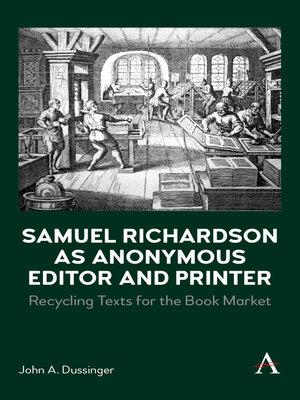Samuel Richardson as Anonymous Editor and Printer
ebook ∣ Recycling Texts for the Book Market
By John A. Dussinger

Sign up to save your library
With an OverDrive account, you can save your favorite libraries for at-a-glance information about availability. Find out more about OverDrive accounts.
Find this title in Libby, the library reading app by OverDrive.



Search for a digital library with this title
Title found at these libraries:
| Loading... |
Owing to the pioneering work of William Sale and Keith Maslen, which produced a catalogue of printer's ornaments belonging exclusively to Samuel Richardson's business, we now have an invaluable method for identifying the many publications issuing from the Salisbury Court shop. This study adds a number of new titles to the Maslen catalogue and also examines stylistic evidence in supporting attributions of anonymous texts. A number of books from Richardson's press are found to be unacknowledged digests of works already in print, and in some cases manuscripts of letters were appropriated as raw material for an essay or pamphlet.
From the beginning of his career as printer, Richardson consistently worked as an anonymous editor and compiler while manufacturing books from his press. While setting type for his many newspapers and journals, this major London printer was mainly concerned about generating a readership and thus invoked all the tricks of his trade to arouse interest in his readers. Without ever asserting himself as the author, Richardson produced many letters to the editor as a means of invoking a collective response without risking the responsibility of answering for the opinions expressed in his letters. It was a rhetorical strategy that worked very well for a printer who by profession had to publish many works that expressed opinions wholly in conflict with his own. His long experience as anonymous editor prepared him in launching fictional "histories" told through multiple voices that conceal or underplay a central author's authority.
|During the first two decades of his career, Richardson's role as printer was hardly limited to setting the type for the periodicals that issued from his shop. Perhaps the most glaring evidence of his intervention in producing text is the fact that both The True Briton (1723-24) and The Weekly Miscellany (1732-41) just happen to have letters supposedly from women who protest the legal restraints against their participation in the public sphere. Neither the Duke of Wharton, the owner of The True Briton, nor William Webster, the desperately impecunious producer of The Weekly Miscellany, launched their journals with the objective of advancing radical views about political equality for women. But almost inadvertently this middle-aged, rotund printer at Salisbury Court was quietly feminizing journalism. After his first experiments in Wharton's anti-Walpole journal he developed his satiric powers in the Miscellany by creating not only his own feisty counterpart to Pope's coquette Belinda but even partnering with Sarah Chapone's subversive Delia. As an outlier in what was perceived to be a corrupt, predatory political world, Richardson readily assumed a female voice to express his resistance.






